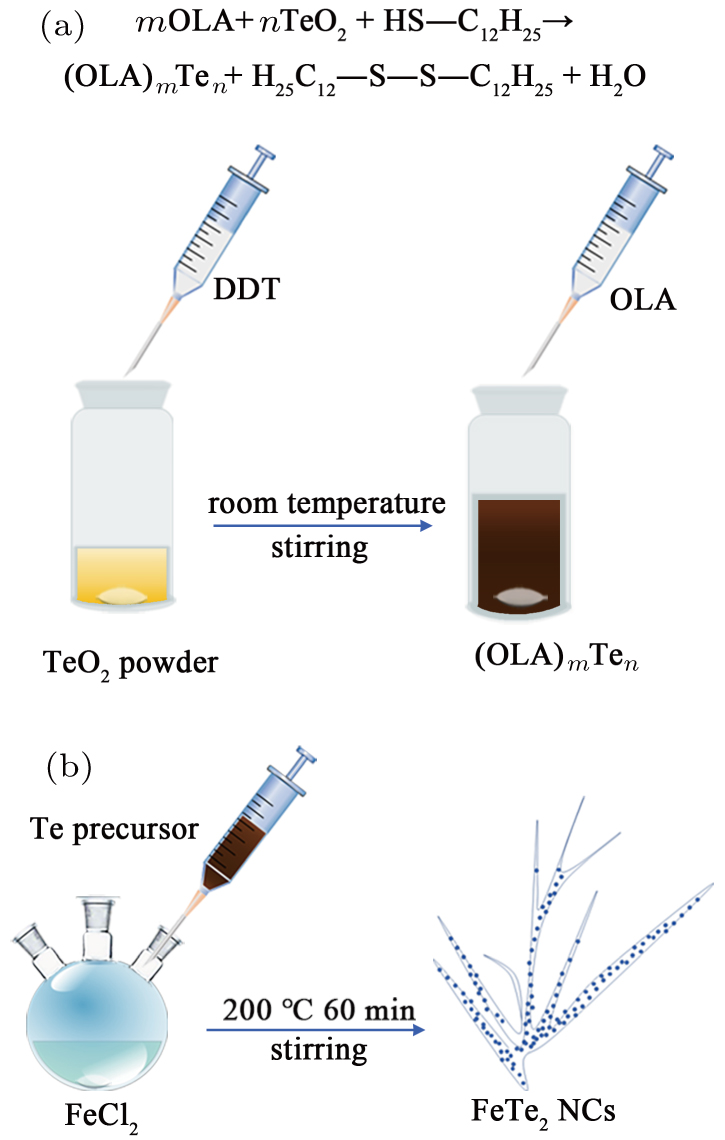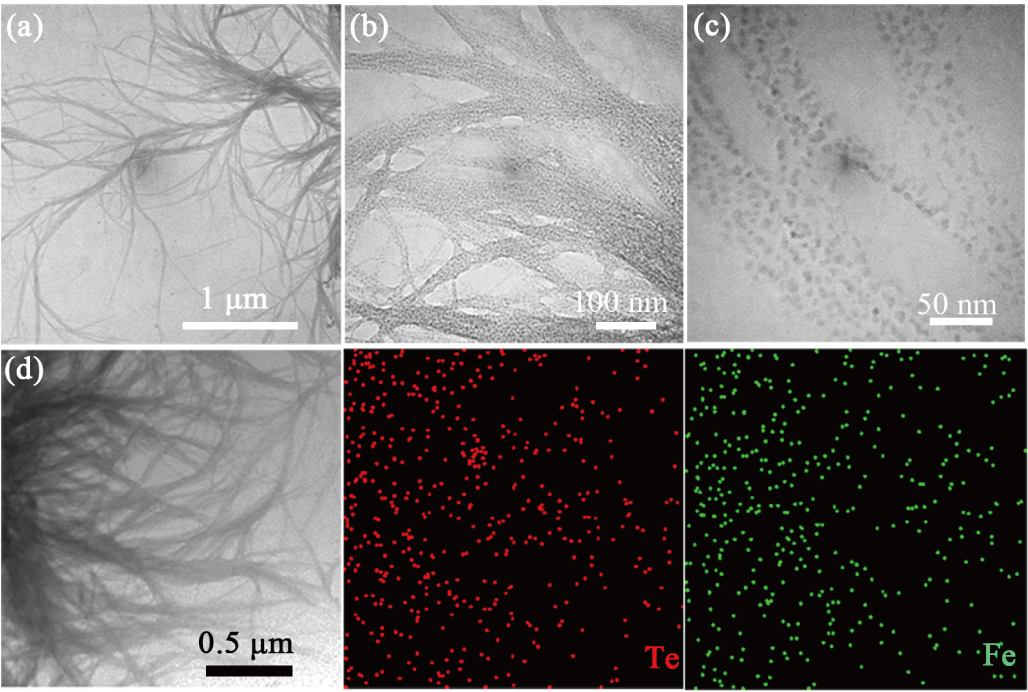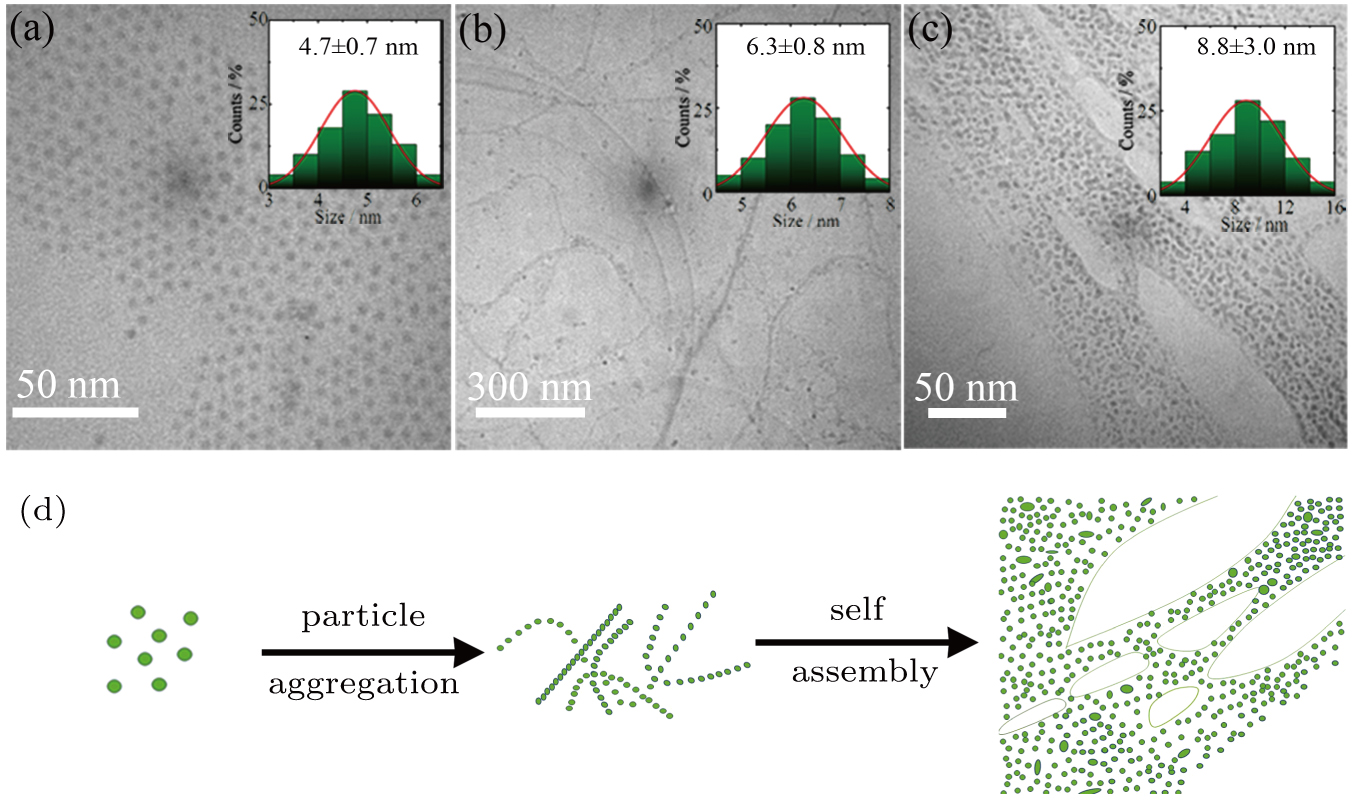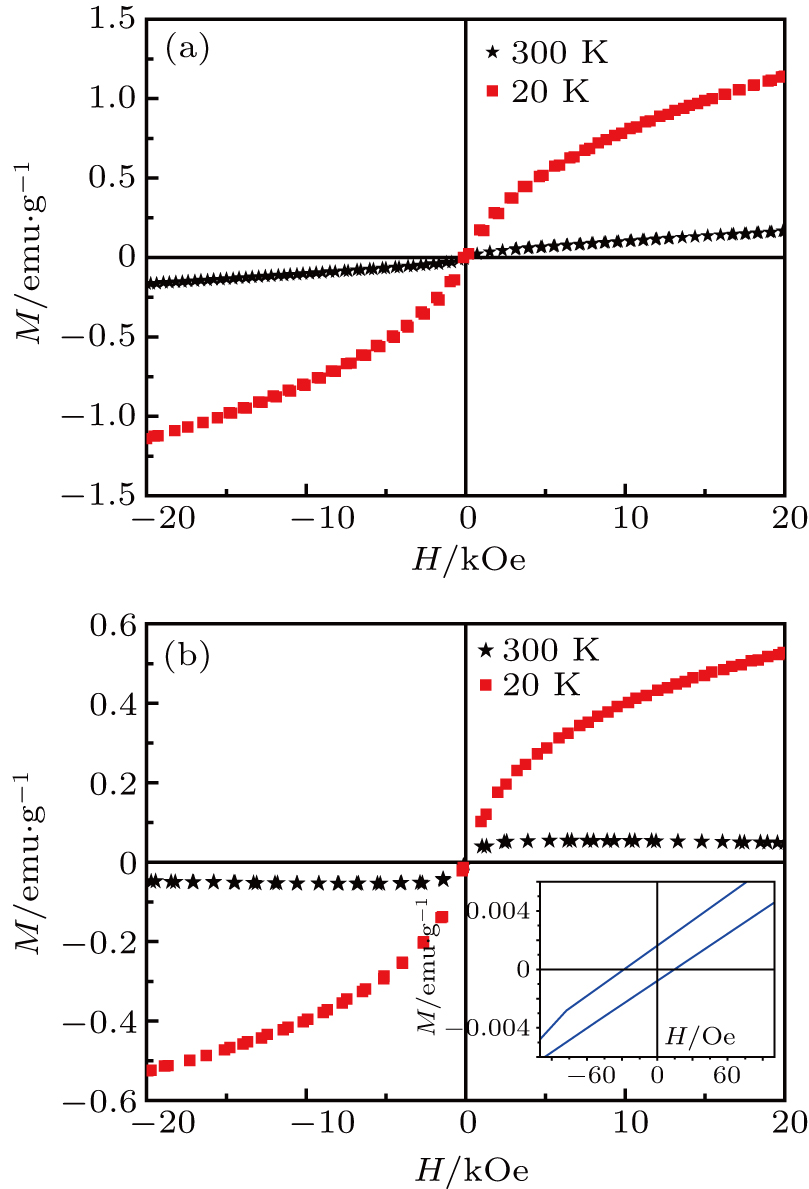† Corresponding author. E-mail:
Manipulating the self-assembly of transition metal telluride nanocrystals (NCs) creates opportunities for exploring new properties and device applications. Iron ditelluride (FeTe2) has recently emerged as a new class of magnetic semiconductor with three-dimensional (3D) magnetic ordering and narrow band gap structure, yet the self-assembly of FeTe2 NCs has not been achieved. Herein, the tree-like FeTe2 nanoarchitectures with orthorhombic crystal structure have been successfully synthesized by hot-injection solvent thermal approach using phosphine-free Te precursor. The morphology, size, and crystal structure have been investigated using transmission electron microscopy (TEM), high-resolution TEM (HRTEM), and powder x-ray diffraction (XRD). We study the formation process of tree-like FeTe2 NCs according to trace the change of the sample morphology with the reaction time. It was found that the FeTe2 nanoparticles show oriented aggregation and self-assembly behavior with the increase of reaction time, which is attributed to size-dependent magnetism properties of the samples. The magnetic interaction is thought to be the driving force of nanoparticle self-organization.
Transition metal telluride (TMT) nanocrystals (NCs) have received significant interest owing to their unique and excellent properties, which offer a wide range of applications in thermoelectrics,[1,2] superconductors,[3] biomedical sciences,[4,5] magnetic semiconductors,[6] and photovoltaics.[7,8] Rational modulation of TMT NCs with a tailored crystal phase, shape, size and/or assembly structure, is of high significance with respect to the engineering of the electronic, optical, and magnetic properties for the design of nanoscale devices with novel functions. Specifically, assembly of uniform nanocrystal building blocks provides a fundamental strategy for the generation of meso- and macro-scale nanomaterials.[9,10] Much effort tends to take advantage of NCs as ideal building blocks for the self-assembly into one-dimensional (1D) orderd-array structures, which embody unusual properties and potential uses in both mesoscopic research and the development of nano-devices.[11–14] Many driving forces[15–28] including entropy, ligand–ligand interactions, and magnetic interaction, are contributed to the formation of self-assembly. Recently, magnetic NCs have been widely demonstrated as self-assembly blocks, which depend on the magnetic dipolar interactions of particles of a certain size.[29,30] In this respect, Xu et al. used the magnetic dipoles inherently associated with magnetic nanoparticles to form 1D assemblies of NCs.[24] However, the green synthesis and self-assembly of TMT NCs still remain great challenges.
Among of TMTs, iron ditelluride (FeTe2) is an important magnetic semiconductor with narrow band gap, which is known to exhibit 3D magnetic ordering structure. Various FeTe2 nanostructures, such as quantum dots,[31] nanorods,[32,33] and nanosheets,[34] have been prepared by hydrothermal and/or solvothermal method or chemical vapor deposition over the past decade. For instance, Zhang et al. reported a hydrothermal route to prepare orthorhombic FeTe2 nanorods in the presence of a certain concentration of KOH.[32] Oyler et al. have successfully fabricated FeTe2 nanosheets via a hot-injection route using hexadecylamine, trioctylphosphine oxide, trioctylphosphine, telluride powder, and [Fe(CO)5].[34] Until now, great endeavors have been devoted to developing facile green synthesis techniques that fabricate TMT NCs. For this purpose, we have recently developed a new strategy for fabricating TMT NCs, e.g., CdTe, PbTe, Cu2Te, and FeTe2 NCs, by using a highly reactive phosphine-free Te precursor.[31] Despite remarkable synthesis progress in the past decades, the design and construction of the self-assembly FeTe2 NCs have not yet been reported.
In this work, we report on the synthesis of FeTe2 NCs with tunable sizes and their self-assemblies into the tree-like nanoarchitectures by hot-injection solvothermal method using phosphine-free Te precursor. In this process, we systematically explored the formation process of tree-like FeTe2 nanoarchitectures, and found that the present synthetic process is virtually a combination of oriented aggregation and self-assembly. First, FeTe2 nanoparticles undergo oriented aggregation to form pearl-necklace aggregates. Second, self-assembly process takes place in the shape-defined aggregation, resulting in tree-like FeTe2 aggregates. These FeTe2 nanoparticles display size-dependent paramagnetic–ferromagnetic phase transition at room temperature. This microscopic magnetic behavior affects the macroscopic morphology of the FeTe2, driving the self-assembly of nanoparticles into the tree-like nanoarchitectures.
Anhydrous FeCl2 (in purity 99.99%) and TeO2 powder (in purity 99%) were purchased from Sigma–Aldrich. Dodecanethiol (DDT, 98%), oleylamine (OLA, 80%) were purchased from Alfa Aesar. Methanol, toluene and acetone were obtained from commercial sources. All chemicals were used without further purification.
Typically, a mixture of DDT (2.0 mL) and TeO2 powder (0.2 mmol) was loaded into a 20-mL flask and stirred for 5 min at room temperature. Then, the 2.0-mL OLA solution was injected into the mixture to obtain a black solution under a nitrogen atmosphere.
Typically, a mixture of anhydrous FeCl2 powder (0.1 mmol) and OLA (5 mL) was loaded into a 50-mL three-neck flask and heated to 200 °C for 10 min under a nitrogen atmosphere to obtain a clear solution.
At the temperature point 200 °C, the OLA–Te precursor was injected into the OLA–Fe precursor. The reaction was allowed to proceed at 200 °C for 60 min. Then, the mixture was cooled to room temperature naturally. The resultant NCs were isolated from the growth solution by precipitation with methanol and excess acetone followed by centrifugation for 3 min at 12000 rpm. Subsequently, the residual samples were redispersed in toluene for characterization.
The transmission electron microscopy (TEM), high-resolution TEM (HRTEM), high-angle annular dark-field scanning transmission electron microscopy (HAADF-STEM), and elemental mapping images were performed on a JEM-2200FS operating at an acceleration voltage of 200 kV. Composition of the specimens was analyzed with an energy-dispersive x-ray spectroscopy (EDX) was collected from the attachment to the JEM-2200FS. Powder x-ray diffraction (XRD) data were collected on a Bruker D8 diffractometer working with a Cu–Kα target. Magnetic measurements were carried out by a Quantum Design MPMS SQUID VSM magnetometer.
Compared with other metal chalcogens, TMTs are much harder to be synthesized owing to the challenge of the preparation of soluble low-toxicity Te precursor.[35–39] OLA–Te, prepared by dissolving TeO2 in DDT, is an efficient phosphine-free Te source for the synthesis of metal tellurides NCs in our previous works.[31] Here, we report on a strategy for synthesizing tree-like FeTe2 nanoarchitectures by triggering the self-assembly of nanoparticles, in which the preparation process is divided into two parts: (i) the rapid preparation of soluble phosphine-free Te precursor, (ii) the formation of the solution-based tree-like FeTe2 nanoarchitectures (Fig.
 | Fig. 1. (a) Schematic diagram for the preparation of the phosphine-free Te precursor and the reaction mechanism. (b) Schematic diagram for the synthesis of FeTe2 NCs obtained at 200 °C, 60 min. |
The morphology of the produced FeTe2 NCs are characterized by transmission electron microscopy (TEM). Figure 
 | Fig. 2. (a)–(c) TEM images of FeTe2 nanoarchitectures for different magnifications. (d) STEM–EDS mapping of the as-prepared FeTe2 nanoarchitectures. |
In order to study the formation process of tree-like nanostructures, we track the change of sample morphology with the increasing reaction time. Figure 
To further inspect the self-assembly behavior of FeTe2 nanoparticles, we investigated magnetic properties of the samples with different particle sizes. The temperature dependence of magnetization measured in an applied field of 1000 Oe 
 | Fig. 4. Temperature dependence of FC and ZFC susceptibilities for (a) 4.7 nm and (b) 8.8 nm FeTe2 NCs. |
To gain further insight into the magnetic properties of the synthesized 4.7-nm and 8.8-nm FeTe2 NCs, the magnetization dependence on the applied magnetic field (hysteresis loop) has been recorded at 20 K and 300 K (Fig.
In summary, we have proposed a facile way to fabricate FeTe2 NCs using highly reactive phosphine-free Te precursor by hot-injection solvent thermal method. We systematically explored and found that the formation process of tree-like FeTe2 nanoarchitectures is a combination of oriented aggregation and self-assembly. Initially, the FeTe2 nanoparticles with a high degree of monodispersity are formed after nucleation. Subsequently, the FeTe2 nanoparticles undergo oriented aggregation to form the “pearl-necklace” agglomerates. Then, these “pearl-necklace” agglomerates spontaneously assemble into the tree-like nanoarchitectures. The magnetization measurements show the size-dependent magnetic properties of FeTe2 NCs, driving the self-assembly of nanoparticles into the tree-like aggregates. This work provides a simple green approach to integrate FeTe2 NCs with self-assembly behavior, which is suitable for subsequent processing into quantum-confined superstructures, materials, and devices.
| [1] | |
| [2] | |
| [3] | |
| [4] | |
| [5] | |
| [6] | |
| [7] | |
| [8] | |
| [9] | |
| [10] | |
| [11] | |
| [12] | |
| [13] | |
| [14] | |
| [15] | |
| [16] | |
| [17] | |
| [18] | |
| [19] | |
| [20] | |
| [21] | |
| [22] | |
| [23] | |
| [24] | |
| [25] | |
| [26] | |
| [27] | |
| [28] | |
| [29] | |
| [30] | |
| [31] | |
| [32] | |
| [33] | |
| [34] | |
| [35] | |
| [36] | |
| [37] | |
| [38] | |
| [39] |



